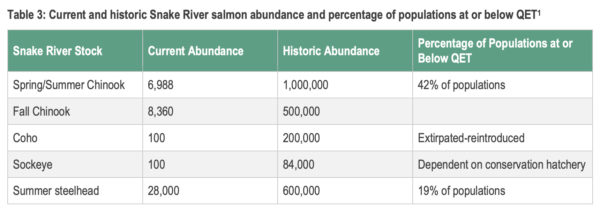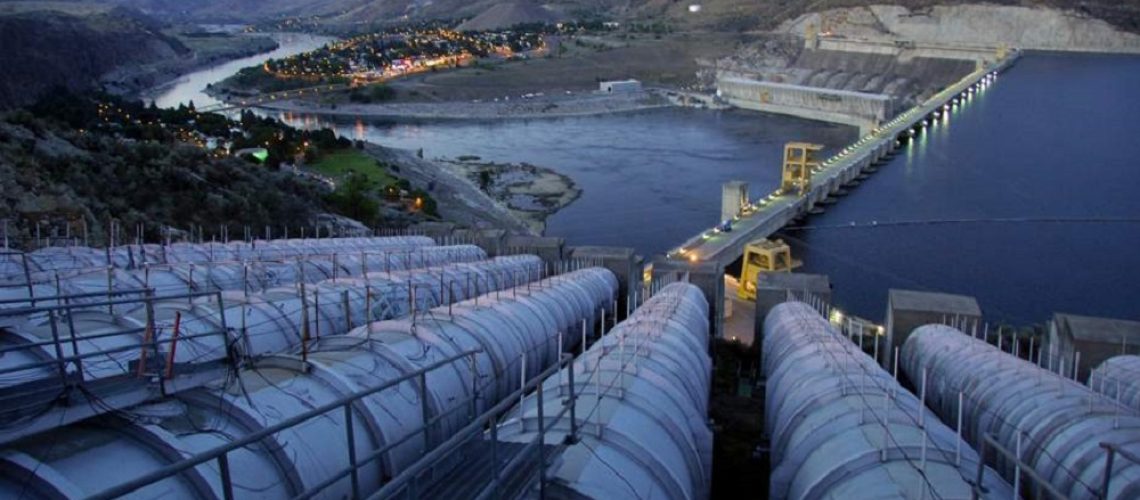In a race between governmental processes and the process of extinction, legislators in Washington State consider replacing hydro dams with solar and wind in an attempt to save the salmon.
A process launched by Governor Jay Inslee and US Senator Patty Murray, both of Washington, is evaluating breaching four dams in the lower Snake River, and replacing their generating capacity with renewables.
The potential to increase salmon populations in the Snake River basin is the “main factor” prompting interest in breaching the dams, says a draft report commissioned by Governor Inslee’s office. The locations of the four dams, all in southeast Washington, are shown in the image below with the labels 5, 6, 7 and 8.
Building 1.3 GW of solar, 1.4 GW of wind power and 0.2 GW of battery capacity would be the lowest-cost option for replacing the four dams’ annual generation in a way that would balance the region’s substantial remaining hydropower generation. That resource mix would provide high output in late summer, when electrical load is high and hydropower output is low. That’s according to an analysis, cited in the draft report, prepared by the energy consultancy Energy Strategies.
The four dams produce about 11% of the total hydropower generation from 31 federal dams in the Columbia River basin, and about 4% of all generation in the Pacific Northwest, the draft report says.
Salmon recovery
Chinook salmon populations in the Snake River, a major tributary of the Columbia River, have fallen 99% from their historic abundance, from 1.5 million to 15,000, the draft report shows, with similar declines in populations of other fish species. The data were compiled by a task force convened by the US agency NOAA Fisheries and its Marine Fisheries Advisory Committee.

Many runs of Snake River salmon and steelhead “are rapidly reaching the quasi-extinction threshold (QET), or the point at which population levels are so low that the population is uncertain to persist, and the probability of recovery is low without substantial intervention,” says the draft report, citing data reported by the Nez Perce Tribe. The image above presents data illustrating this point.
“The dams’ impact to salmon runs was predicted in advance by tribes and others,” the draft report adds.
The proposal to breach the dams “represents the most significant action considered to date to reverse the cumulative trend toward destruction of tribal resources, the taking of tribal Treaty-protected wealth by non-Indians, and the consequent damaging of tribal peoples,” says a report from the Columbia River Inter-Tribal Fish Commission, which represents four tribes in the area.
The National Congress of American Indians adopted a resolution last year calling for federal funding to restore the lower Snake River by breaching the four lower Snake River dams.
Congressional authorization would be needed for the Army Corps of Engineers, which operates the four dams, to pursue breaching the dams, says the draft report for Governor Inslee. The draft report lists five more procedural steps to moving forward with dam breaching: “establishing timelines and milestones for results, agreement on a comprehensive funding strategy, additional analyses to maximize benefits at all stages of the process, continued technological advancements and implementation of a significant infrastructure program.”
A Nez Perce Tribe staff presentation last year reported that 42% of the Snake River Basin spring/summer Chinook salmon populations have natural origin spawner abundance at or below the quasi-extinction threshold of 50 spawning fish, with 77% of the populations predicted to drop below the critical level of 50 spawners by 2025.
Cost and benefits
The draft report for Governor Inslee focuses on the cost to replace the electricity and other services provided by the dams and their reservoirs.
Benefits of recreational fishing that’s been improved by restoring the salmon fisheries in the Columbia River Basin have been estimated at $1 billion in annual revenues, the draft report says. The potential value of improving the Pacific Ocean commercial salmon fishery is not estimated; some of those benefits would flow to tribes due to treaty rights.
Breaching the dams would drain the four reservoirs behind the dams, says the draft report, allowing tribal peoples to return to more than 600 locations, “where they were accustomed to live, fish, and hunt.”
Public comments on the draft report will be accepted through July 11, 2022.



